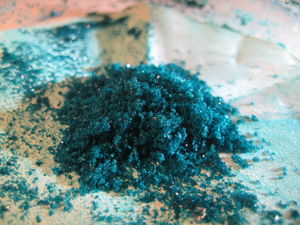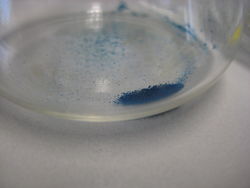Difference between revisions of "Copper(II) acetate"
Diachrynic (Talk | contribs) m (added caption) |
Diachrynic (Talk | contribs) |
||
| Line 7: | Line 7: | ||
| OtherNames = Copper acetate<br>Copper(II) ethanoate<br>Copper diacetate<br>Cupric acetate<br>Verdigris | | OtherNames = Copper acetate<br>Copper(II) ethanoate<br>Copper diacetate<br>Cupric acetate<br>Verdigris | ||
<!-- Images --> | <!-- Images --> | ||
| − | | ImageFile = | + | | ImageFile = Copper_acetate2.jpg |
| ImageSize = 300 | | ImageSize = 300 | ||
| ImageAlt = | | ImageAlt = | ||
| ImageName = | | ImageName = | ||
| − | | ImageCaption = Copper(II) acetate monohydrate | + | | ImageCaption = Copper(II) acetate monohydrate |
| ImageFile1 = | | ImageFile1 = | ||
| ImageSize1 = | | ImageSize1 = | ||
| Line 109: | Line 109: | ||
}} | }} | ||
}} | }} | ||
| − | '''Copper(II) acetate''' or '''cupric acetate''' is a salt of copper with the formula '''Cu(CH<sub>3</sub>COO)<sub>2</sub>''', sometimes shortened to '''Cu(OAc)<sub>2</sub>'''. Copper(II) acetate is generally encountered as monohydrate. Anhydrous Cu(OAc)<sub>2</sub> is a dark green crystalline solid, while the monohydrate is more bluish-green. | + | '''Copper(II) acetate''' or '''cupric acetate''' is a salt of copper with the formula '''Cu(CH<sub>3</sub>COO)<sub>2</sub>''', sometimes shortened to '''Cu(OAc)<sub>2</sub>'''. Copper(II) acetate is generally encountered as monohydrate. Anhydrous Cu(OAc)<sub>2</sub> is a dark green crystalline solid, while the monohydrate is more bluish-green. |
==Properties== | ==Properties== | ||
| Line 122: | Line 122: | ||
===Physical=== | ===Physical=== | ||
| − | Copper(II) acetate is a dark green (anhydrous) or blue-green (monohydrate) solid, soluble in water. | + | Copper(II) acetate is a dark green (anhydrous) or blue-green (monohydrate) solid, soluble in water.<ref>http://woelen.homescience.net/science/chem/exps/copper_acetates/index.html</ref> Copper(II) acetate has a color that is slightly difficult to properly capture on camera. [[File:Copper_acetate.jpg|250px|thumb|right|Copper(II) acetate in small crystals]] |
==Availability== | ==Availability== | ||
| Line 138: | Line 138: | ||
Anhydrous copper(II) acetate can be made by heating the monohydrate at 100 °C in a vacuum. | Anhydrous copper(II) acetate can be made by heating the monohydrate at 100 °C in a vacuum. | ||
| + | |||
| + | Copper(II) acetate can also be prepared from copper(II) hydroxide or basic copper carbonate by the addition of acetic acid followed by evaporation of the solution.<ref>https://en.crystalls.info/Copper(II)_acetate</ref> | ||
==Projects== | ==Projects== | ||
| Line 143: | Line 145: | ||
*Grow large crystals | *Grow large crystals | ||
*Pigment | *Pigment | ||
| + | *Preparation of cis- and trans-Bis(glycinato)copper(II) Monohydrate<ref>https://webs.wofford.edu/hilljb/Chem%20323/CopperGlycine.pdf</ref> | ||
==Handling== | ==Handling== | ||
Revision as of 15:23, 10 March 2019
 Copper(II) acetate monohydrate
| |
| Names | |
|---|---|
| IUPAC names
Copper(II) acetate
Tetra-μ2-acetatodiaquadicopper(II) (hydrated) | |
| Other names
Copper acetate
Copper(II) ethanoate Copper diacetate Cupric acetate Verdigris | |
| Identifiers | |
| Jmol-3D images | Image |
| |
| Properties | |
| CuC4H6O4 Cu(CH3COO)2 | |
| Molar mass | 181.63 g/mol (anhydrous) 199.65 g/mol (hydrate) |
| Appearance | Dark green crystalline solid (anhydrous) Blue-green crystalline solid (monohydrated) |
| Odor | Odorless |
| Density | 1.882 g/cm3 (hydrate) (at 20 °C) |
| Melting point | Decomposes above 145 °C[1] |
| Boiling point | 240 °C (464 °F; 513 K) |
| 7.2 g/100 mL (hydrated) | |
| Solubility | Soluble in ethanol Slightly soluble in diethyl ether and glycerol |
| Hazards | |
| Safety data sheet | FischerScientific |
| Lethal dose or concentration (LD, LC): | |
| LD50 (Median dose)
|
710 mg/kg oral (rat) |
| Related compounds | |
| Related compounds
|
Copper(I) acetate |
| Except where otherwise noted, data are given for materials in their standard state (at 25 °C [77 °F], 100 kPa). | |
| Infobox references | |
Copper(II) acetate or cupric acetate is a salt of copper with the formula Cu(CH3COO)2, sometimes shortened to Cu(OAc)2. Copper(II) acetate is generally encountered as monohydrate. Anhydrous Cu(OAc)2 is a dark green crystalline solid, while the monohydrate is more bluish-green.
Contents
Properties
Chemical
Copper(II) acetate can be used to couple terminal alkynes to give a 1,3-diyne, process known as Eglinton reaction:
- Cu2(OAc)4 + 2 RC≡CH → 2 CuOAc + RC≡C−C≡CR + 2 HOAc
Heating a mixture of anhydrous copper(II) acetate and copper metal yields copper(I) acetate:
- 2 Cu + Cu2(OAc)4 → 4CuOAc
Physical
Copper(II) acetate is a dark green (anhydrous) or blue-green (monohydrate) solid, soluble in water.[2] Copper(II) acetate has a color that is slightly difficult to properly capture on camera.Availability
Copper(II) acetate can be purchased online.
Preparation
Copper(II) acetate monohydrate can be made by reacting a copper base with acetic acid.
- 2 CH3COOH + CuO → Cu(CH3COO)2 + H2O
- 2 CH3COOH + Cu(OH)2 → Cu(CH3COO)2 + H2O + 2H2O
Common vinegar can be used for this reaction, though impurities will precipitate when the solution is concentrated.
If you want to use copper metal, you will also need to add diluted hydrogen peroxide to the solution.
Anhydrous copper(II) acetate can be made by heating the monohydrate at 100 °C in a vacuum.
Copper(II) acetate can also be prepared from copper(II) hydroxide or basic copper carbonate by the addition of acetic acid followed by evaporation of the solution.[3]
Projects
- Make glacial acetic acid
- Grow large crystals
- Pigment
- Preparation of cis- and trans-Bis(glycinato)copper(II) Monohydrate[4]
Handling
Safety
Copper(II) acetates is irritant and toxic.
Storage
Copper(II) acetate should be stored in closed bottles. The anhydrous form should be kept in air-tight containers.
Disposal
Can be reduced with a metal such as zinc or iron to metallic copper which can be recycled.
References
- ↑ http://pubs.acs.org/doi/pdf/10.1021/ed053p397
- ↑ http://woelen.homescience.net/science/chem/exps/copper_acetates/index.html
- ↑ https://en.crystalls.info/Copper(II)_acetate
- ↑ https://webs.wofford.edu/hilljb/Chem%20323/CopperGlycine.pdf
Relevant Sciencemadness threads
- Chemical pages without CAS Registry Number
- Articles without EBI source
- Chemical pages without ChemSpiderID
- Chemical pages without DrugBank identifier
- Articles without KEGG source
- Articles without InChI source
- Articles without UNII source
- Articles containing unverified chemical infoboxes
- Chemical compounds
- Organic compounds
- Copper compounds
- Acetates
- Easily prepared chemicals
